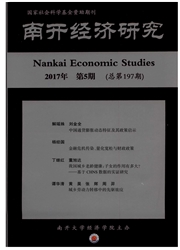

 中文摘要:
中文摘要:
总量增长伴随着结构失衡是中国六十多年来经济发展的一个特征事实。在一般性的理论层面上,我们发现这是政府主导经济发展的阿基里斯之踵:为追求总量增长最大化,政府实施的(产业、地区、城乡等)部门专用的异质性政策会引发部门间的结构失衡。基于泰尔熵指数所测度的部门间结构失衡,本文通过引入部门要素密度异质性与部门专用政策异质性,拓展了Barro(1990)经典的政府公共服务内生增长模型,揭示了为增长而失衡的机制。对中国城乡二元经济与省份区域经济近六十年的经验数据分析,也揭示了中国式发展存在为增长而失衡的机制。在取得较高总量增长的成就之后,结构失衡业已成为中国经济发展的困境,未来须熨平过度倾斜性的部门专用政策,拿捏好在总量增长与结构失衡之间的取舍。
 英文摘要:
英文摘要:
Economic growth accompanied by structural disparity has long been a styled fact of China's economy.Theoretically, we deem it is Achilles' heel that a government leading economic development implements the specific-sector policies which would induce the structural disparity among sectors to pursue to maximize the rate of gross growth.The main missions of this paper are as following: firstly, via Theil Index, we discuss the concept and measure of strnctural disparity among sectors; secondly, through introducing the heterogeneity of factor intensity and specific-sector policies, we expand the model of Barro (1990) to uncover the mechanism of disparity for growth by government; lastly, the mechanism is supported by the empirical analysis of data on the dual economy and regional economy during last about 60 years in China.After the great achieving of gross growth, structural disparity will have become a major dilemma in China's development in the future.It should be the orientation of deepen reform implemented by Chinese government to iron the policy inclination and consider the trade-offbetween gross growth and structural disparity.
 同期刊论文项目
同期刊论文项目
 同项目期刊论文
同项目期刊论文
 期刊信息
期刊信息
